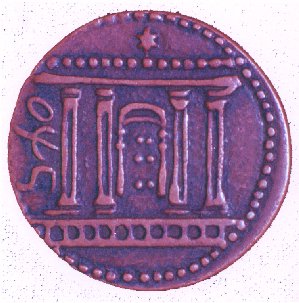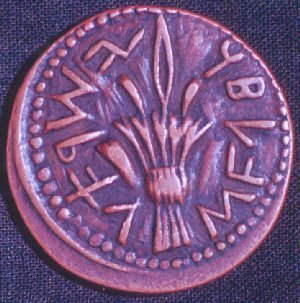The Bar Kokhba Coin from Clay City, Kentucky


Photos Dr. Fred Coy, Jr.
Click on above photos for 600-700 KB blowups.


Photos Dr. Fred Coy, Jr.
Click on above photos for 600-700 KB blowups.
The coin was soon identified by Dr. Ralph Marcus of the University of Chicago as a coin of the Second Revolt of the Jews against Rome, under Simon Bar Kokhba (or Cochba) in AD 132-5. A genuine coin of this type may be viewed on the American Numismatic Society's website by clicking here. The obverse side depicts the facade of the Second Temple of Jerusalem, destroyed by the Romans during the First revolt in 70 AD, which Bar Kokhba was determined to restore, and bears the name Simon in Old Hebrew letters. The reverse depicts a lulav (palm branch bundle) and ethrog (citron), and reads "Year 2 of the Freedom of Israel" (133 AD). (Cp. Leo Mildenberg, The Coinage of the Bar Kokhba War, Verlag Sauerländer, Salzburg, 1984, # 38.)
The Clay City coin and two other Bar Kokhba coins from Kentucky gained currency, so to speak, when they were cited by Cyrus H. Gordon (Before Columbus, New York, Crown, 1971, Appendix) as perhaps being related to the similarly Old Hebrew inscription on the Smithsonian's Bat Creek Stone.
In an extensive survey of "Pre-Columbian Old World Coins in America" (Current Anthropology, Vol. 21 No. 1, Feb. 1980, pp. 1-20), Jeremiah F. Epstein devotes almost a page to the Kentucky Bar Kokhba coins. He reports that he sent a photocopy of a newspaper photograph of the Clay City coin to Yaakov Meshorer, an expert on Jewish coins, for evaluation. Meshorer replied on March 3, 1978 that he had identified the coin as a forgery from the beginning of the 20th century, a replica made for sale to pilgrims and tourists to the Holy Land.
Since Marcus, whom Epstein acknowledges as an outstanding expert on Josephus, had examined the coin first-hand, while Meshorer had only a photocopy of a grainy newspaper photo to go by, it seemed prudent to obtain some "second opinions" based on a decent photograph at the very least.
Pat White of Columbus, OH, was able to locate the current owner of the Clay City coin, a niece of the finder Robert Cox. The owner and her husband kindly sent me the above excellent photographs of the coin, that had been taken by Dr. Fred Coy, Jr., of Louisville, Ky.
I sent the above scans of Coy's photographs to Mr. Haim Gitler, curator of numismatics at the Israel Museum in Jerusalem, as well as to Mr. David Hendin of Amphora Coins in New York. Both quickly confirmed Meshorer's opinion that the coin is a modern replica and not a genuine ancient coin. Although Marcus was an acknowledged expert on the historical literature pertaining to this period, he apparently did not have the numismatical expertise of Meshorer, Gitler or Hendin that would have allowed him to tell a genuine coin from a modern replica.
Gitler and Hendin did not elaborate on specifics, but it is my understanding that the following would be a few of the points against it:
How could even a replica of a Bar Kokhba coin end up in a field in Kentucky, 40 miles from the nearest city of any size? We will never know, but the scenario I would envision is that at some time in the early 20th century, these replicas may have been distributed throughout the Bible Belt by religious supply merchandisers as inexpensive mementos of the Holy Land. They might then have been given out to youths as prizes for perfect attendance in Sunday School, lost here and there, and then recovered by sharp-eyed observers like Mr. Cox decades later.
It is worth noting that it was Mr. Cox himself, an avid Bible reader, who first identified the coin as Jewish, from a photograph of a similar coin in a Biblical reference book he owned, even though it was left for Prof. Marcus to actually read the inscription. Bar Kokhba coins were therefore a well-established part of the tradition of religious history, even in rural Kentucky.
Despite the negative call on this coin, it remains an important part of the discussion, pro and con, of the possibility of pre-Columbian contacts, and the owner and her husband are to be praised for faithfully retaining it all these years and permitting it to be studied.
I'm still working on getting photographs of a second Bar Kokhba coin from Kentucky, found in 1932 in Louisville, and will ask Gitler and Hendin for their taken on it as well. A third Bar Kokhba coin from Hopkinsville, KY, was reported in 1967, but is probably untraceable. Epstein (p. 10) mentions that a fourth Bar Kokhba coin from Alcolu, South Carolina, about 17 miles south of Sumter (Sumter Daily Item, Jan. 4, 1977), was also identified by Meshorer as a 50-60 year-old forgery, from good photographs in this case. Barry Fell (Saga America, Times Books, 1980, p. 168) reports a fifth Bar Kokhba coin, found in 1922 near the Missouri/Arkansas state line just west of the Mississippi River, but does not provide details.